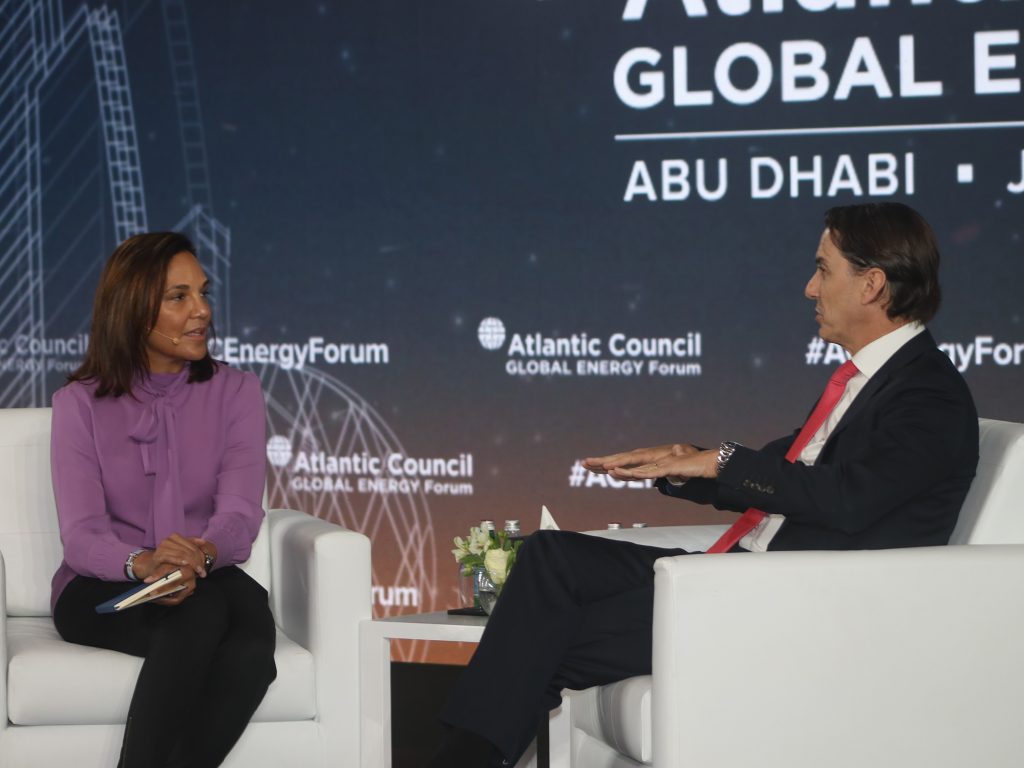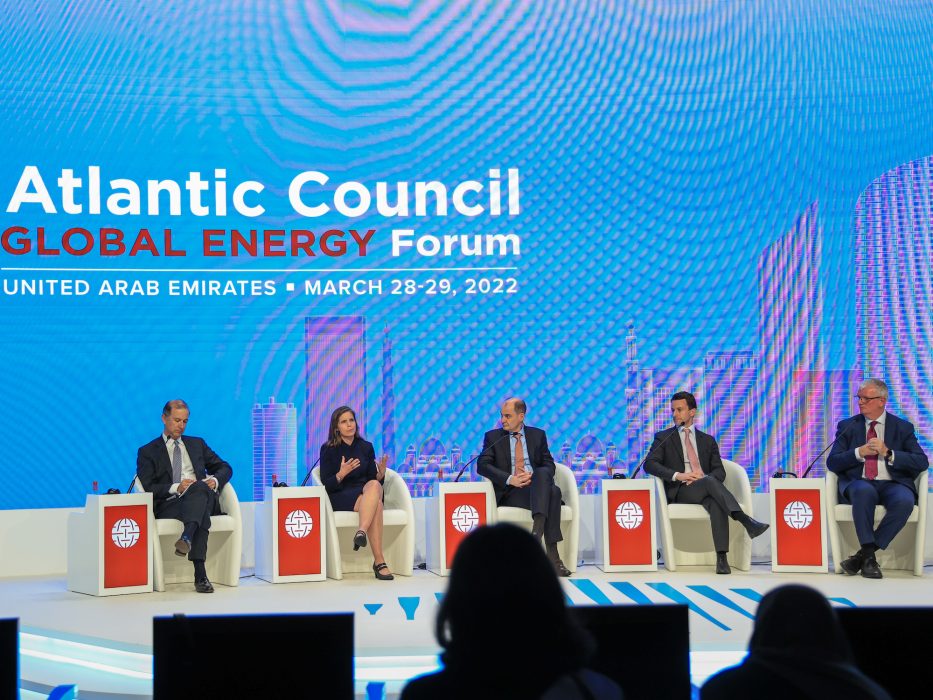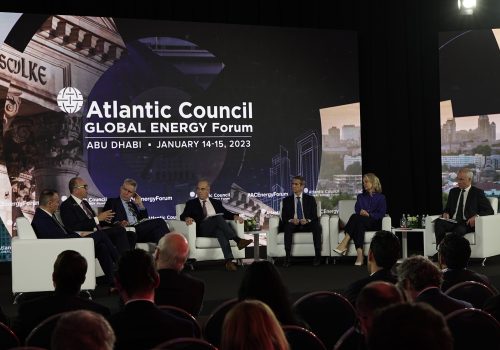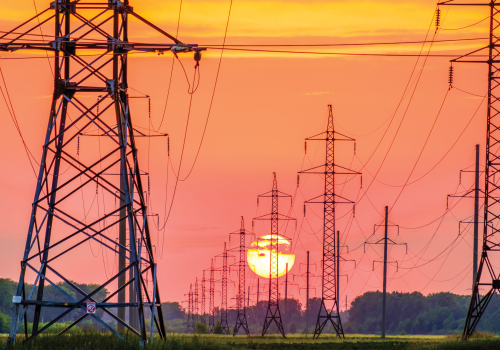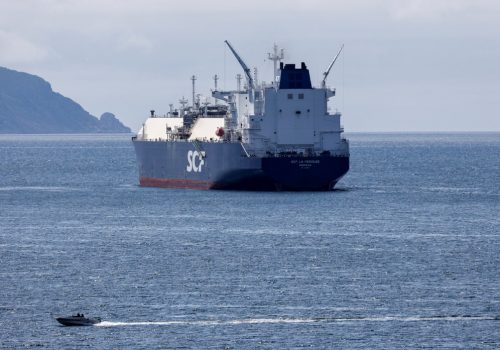Watch the full event
Event transcript
Uncorrected transcript: Check against delivery
Speakers
Amos Hochstein
Special Presidential Coordinator for Global Infrastructure and Energy Security, US Department of State
Moderator
Helima Croft
Managing Director, Global Commodity Strategy, RBC Capital Markets
HELIMA CROFT: There’s been so much discussion at this conference about the challenges of critical minerals—how we need to source more supply, how we need—the unique security challenges of critical minerals. Walk us through, sort of level set for us, what’s the scale of the challenge as we think about meeting Paris climate goals?
AMOS HOCHSTEIN: First, it is always great to be back at the Energy Forum. Last year I tested positive in the airport on the way, so I ended up in a—
HELIMA CROFT: We didn’t tell anybody that, yes.
AMOS HOCHSTEIN: We did not say that at the time, but that’s really why I appeared on a screen from my hotel room in Brussels. But it’s great to be back here in person for many, many reasons.
Look, I actually believe that this is the greatest challenge not just for our ability to meet net-zero goals, but it’s actually one of those things that crosses over to being one of the most important challenges and national security risks overall—not just energy, but a national security risk for the United States and for large parts of the world. And the reason for that is because if we don’t—if we just continue as things are today, as they’ve been developing for the last ten years, we’ll be in a place where we have full control or significant control of critical minerals in the hands of very few and that’s a great challenge.
HELIMA CROFT: You know, Amos, how does this differ from the security challenges of traditional hydrocarbons? And you mentioned concentration risk, but there’s also this issue around China, which is it’s in the hydrocarbon challenge but it also seems to be very, very pronounced when it comes to critical minerals.
AMOS HOCHSTEIN: Well, my view is that if we’re—everybody always thinks about the hydrocarbon world of the twentieth century—
HELIMA CROFT: Yes.
AMOS HOCHSTEIN:—and that we’re now moving to this great new world of the green energy world, which is a better world in many ways, but that somehow that’s going to solve the geopolitical challenges of the energy world.
The way we’re going right now we’re actually creating a carbon copy of the twentieth century geopolitics of energy architecture and just putting it into the twenty-first century. Instead of having a small group of countries that control oil supply and, perhaps, refining, we’re now going to create a one or maybe a couple of countries that will control the entire supply chain for wind, solar, electric vehicles’ chips, and if we do that then the geopolitics of energy of the 1970s will be repeated in the 2030s and 2040s.
HELIMA CROFT: So, Amos, can you just walk us through? I mean, where does it rank? When you think of national security priorities for this administration, you know, where does it rank in terms of, you know, when you go in to see President Biden how concerned is he about critical minerals?
AMOS HOCHSTEIN: I think people don’t always believe me but he actually can talk more about critical minerals and the challenges of the critical minerals than almost—than many in our own government. He understands this challenge very personally. I have had many conversations with him about this.
It’s because if we want to create—and look, we’re at a place we talk about this all the time in this conference, right? Dr. Sultan talked about it yesterday. We have to accelerate the investment in clean energy technology and in renewable energy. That creates a challenge because as you accelerate something more rapidly than the market would normally have developed you have to make sure that you have the raw materials and the supply chain behind it. Right now, we may not.
So, to do that, suddenly there is a rush to buy and to acquire, from mining to processing and refining and assembly, and if you look at where that is right now it’s not in a good place for a diverse—well-diversified energy system.
HELIMA CROFT: Are there particular aspects of it that are especially acute? I think we’ve discussed graphite before as a particular challenge.
AMOS HOCHSTEIN: So if you look at what is the materials that are necessary for batteries or materials that are necessary for wind and you break it down and you look item by item, and suddenly you realize that graphite is mined in many different countries but it’s processed only in one country, and we’re going to have two new processing facilities in the United States likely over the next couple of years. But that will supply a very small percentage of what even just a small percentage of what the United States needs.
And then look at lithium and who’s owning the assets. Who owns the mining? Who owns the processing? Who owns cobalt? Who owns the mining? Where is it going? Nickel, copper. Copper we need not just for batteries. We need it across—if you want to electrify everything copper is really important.
So all of that is right now concentrated in one country: in China. China controls somewhere between 60 [percent] and 100 percent of all the items that I just mentioned. So we have to—as we talk about accelerating the investment, it’s not just about deployment of cells or of turbines and building the grid.
We actually have to accelerate the investment that the rest of the world—this is not just about US versus China. It’s about making sure that we have a diversified energy system and if—I’m not looking to have all the processing in the United States.
HELIMA CROFT: Right. Right.
AMOS HOCHSTEIN: The IRA is definitely intended to build up our own capacities. But we need that around the world.
HELIMA CROFT: So let’s dig into the IRA right now. Can we, basically—you know, we’ve had the IRA, this, you know, groundbreaking legislative, you know, success for the Biden administration. How do you think about the IRA sort of delivering on, you know, the development of this industry in the United States?
AMOS HOCHSTEIN: Well, you have—Piedmont is an American company that’s going to have lithium mining in South Carolina and processing in Tennessee. Same company has assets in Ghana to get—for the mining of lithium. We have multiple examples. Jervois from Australia is just—is going to just announce that they’re opening the first in many decades primary cobalt mine in the United States—not as big as [the Democratic Republic of the Congo (DRC)], but it is a mine. But what I don’t want is all of that cobalt’s right now destined to leave the country, so—because we don’t have processing. So what IRA is doing is creating—if you look at a carrot and a stick to get companies to do things, this is—IRA is all about the carrots. It’s about what are the tax incentives and the grants and other financial incentives for companies to build the capacity that we need.
But Helima, we can’t—
HELIMA CROFT: Right.
AMOS HOCHSTEIN: IRA is about the United States. This is a global issue. We want this to be built, whether it’s lithium in Serbia or projects in Chile, in Argentina, and in Australia. But it’s not enough that they’re built in those countries. Who owns them and where are they going? And you have to look at the next level of the—of the problem. If one country owns all the raw material and one country owns—or all the processed material, then eventually they get to decide where the battery’s going to be built.
HELIMA CROFT: OPEC—
AMOS HOCHSTEIN: And if they get to decide where the battery’s built, then they get to decide perhaps where the car is built. And all of a sudden you have a real challenge where the auto industry—and we know the auto industry moves where the costs are, right? That’s how the United States became a hub for—European and Asian car manufacturers make their cars in the United States when it became cheaper to make them in the United States for the US market. So that’s the real challenge that we’re facing.
HELIMA CROFT: Well, you’ve laid out an enormous challenge. What is the role of getting, you know, obviously, more financing? Like, how do you de-risk financing for this?
AMOS HOCHSTEIN: So that’s—so we launched, together with the—at the G7 we launched something called the Partnership for Global Infrastructure and Investment, which the idea behind it is how do we pool resources from the United States and the G7 members plus others and the MDBs to de-risk investment in these areas. And this is an extraordinarily difficult challenge because you have country risk, commodity risk, currency risk, and ESG risk, and that makes it very difficult.
We’re having initial successes now in—after several months of starting to be able to put together these kinds of packages that allow us to use the financial instruments that we have as governments, whether it’s Ex-Im and DFC in the United States or it’s KFW in Germany or in the United Kingdom, et cetera, the EU, and of course Japan with JBIC. So that—but how do you figure out how to blend where they’re used to de-risk it by taking the first loss or taking and putting that capital where it fits in the capital stack of the investment to make sure that we can incentivize the others? I’m not very optimistic that we’re going to have significant Western financing of mining projects in certain countries around the world where they’re not comfortable, but I think we’re starting to see a success where we can find buyers into the mining side and incentivize processing and refining of those products in a number of those countries, and Serbia is a very good example of that.
HELIMA CROFT: Do you have others you could talk about?
AMOS HOCHSTEIN: I have others that I will be able to talk about.
HELIMA CROFT: You’ll be able to talk about.
So we just attended the Future Minerals Forum in Riyadh, and one of the big issues that was brought up there was the challenge of getting financing in a rising rate environment. I mean, how much does that give you concern?
AMOS HOCHSTEIN: That’s what I lose sleep about every night: How do I solve that problem? And we’ve had conversations. We’ve, you know, spent some time—the US national security adviser and myself spent some time with some of the fund managers to understand their perspective of what does it take. We’ve traveled around to see how do we structure—what do we need to do—in other words, what can the US government or the G7 governments in combination do that would change the outlook of financial institutions, whether it’s banks or it’s private equity? What do we need to do that gets you over that hump?
I think we have a—we have more information today. We’re putting those deals together. We have some transactions that are in their final stages that will demonstrate that we can do this. But the challenge is enormous, and I think part of the challenge is that there’s not enough attention to this challenge.
So what I would say on the financial institutions, I think we have to find a different way to look at not just de-risk the investment, but we have to put in the risk to the final product. If I’m going to say I’m not going to invest in financing the mining or the processing but I will invest in the final product, well, you’re going to have to put a risk now on that final product because you’re going to have to ask them: How are you going to guarantee your supply chain? What if you don’t have it? And suddenly I think if you have that outlook, then perhaps you say, OK, if I’m going to secure my investment in the final product, whether it’s the car or the product itself—or other products—I have to now invest in the supply chain to make sure that it’s there. And I think that’s a mindset change that is slow, and I—because of the lack of understanding of the basic data of where the supply chain actually lives, everybody I give the numbers to always reacts with surprise even if they are people who are heavily invested in the sector.
HELIMA CROFT: So, Amos, I want to ask you, you recently took a trip to the DRC. When you think about, you know, you have been in the seat for energy security for how many decades? I mean, you were at the State Department under President Obama. You were head of the Bureau of Energy and National Resources. And sort of in your career, how much has the energy security portfolio that you’ve had, how much has it changed because of the critical minerals imperative? Like, does it change where you’re spending your time? Like, how does your day-to-day job change because of this?
AMOS HOCHSTEIN: I think, remarkably, it’s the same job with a different set of countries. And I started working on energy security in the 1990s. That ages me a little bit. I turned fifty last week. So in—when I was on the Foreign Affairs Committee actually working on completely other issues, and all of a sudden realizing that we in the United States didn’t talk about energy in foreign policy but every other country did, whether they were consumers and it affected their—how much they subsidized energy and therefore a percentage of their GDP or if they were the providers of energy and therefore it was a big portion of their income.
And today, I see it as exactly the same thing when—OK, so I’m in the DRC because they have 80 percent of cobalt in the world, they have significant copper resources, and they have really great lithium—very high-quality lithium there as well. So they said to me—some folks there without naming names said: We’re the Saudi Arabia of cobalt. That was the statement that was made to me by this individual. And I said: I wish you were, because the Saudi Arabia of cobalt or the Saudi Arabia of actual Saudi Arabia has that resource, and look at what it’s done for the country.
HELIMA CROFT: Right.
AMOS HOCHSTEIN: It’s been able to turn the country around, develop it into a—the major powerhouse, an economic powerhouse that it has—that it is today with institutions and roads and bridges and hospitals and everything else. You’ve had cobalt for all these years. It’s time to think about how do you manage these resources so that the more you put an effort on getting at—rooting out corruption, and putting an emphasis on who are the workers and what their rights are, and the taking care of the country and investing it back, that’s part of the opportunity that all of a sudden, after ten years, the world is really paying attention. We want these products for all these things that we want. This is the opportunity for a whole new set of countries if they—if they decide that they want to be part of this economy, they have an opportunity to become the Saudi Arabia of cobalt or of lithium or of copper, of nickel or graphite, whatever it is.
But if we keep a concentrated market where all these countries are essentially production facilities on a highway to one country, they won’t get that opportunity to develop and to expand their economies and to do what’s right for their people. And the rest of the world will end up with a single supplier for the products that we need the most in order to create this net-zero world that we’re trying to advance.
HELIMA CROFT: Amos, I want to drill a little bit deeper on this because, I mean, clearly the DRC has had, you know, enormous challenges. I mean, think about it was the world’s worst war at one time. Five million people reportedly died in that war. I mean, how do you solve for these enormous governance problems? I mean, the track record in terms of oil countries in sub-Saharan Africa, you know, wasn’t particularly great in the 1990s in early 2000s. You know, think about Nigeria. I mean, how does Congo sort of break the sort of resource curse?
AMOS HOCHSTEIN: So I don’t want to pick on Congo, but I—
HELIMA CROFT: No, no, I know, but it’s an enormous opportunity if they could—this resource. I mean—
AMOS HOCHSTEIN: Right. So I think it’s exactly what you just said: Don’t look at it as a challenge and a problem; look at it as an opportunity. And I think that as—look, we as a world, we want to have—we want to have a net-zero world. We want to all—many of us in this room want to have—drive electric vehicles. But we also want to know that it was built in a certain way and coming from a certain—that the supply chain into it was, first of all, clean so that we actually don’t defeat the purpose, and that worker rights were respected while building these cars and the materials in it. So this is not between—as we are suddenly paying attention to what we drive and what we’re going to consume and what kind of electricity we’re going to have, now we can come and say we want to make sure the countries that are producing it get their fair share, too. And so don’t allow companies that are going to come and bid in your—when you put out a tender that are not going to respect those basic principles.
And it’s remarkable. If you don’t—if you tell them you can’t hire children and you have to have an actual living wage and you have to do all the things that the successful oil and gas countries have done that have developed their economies in a sustainable way, if we take those lessons learned and say—you have the opportunity. You can look at it two ways. You could look at the resource curse countries who failed the resource curse test or the ones that succeeded. And that’s—and that’s what I—I’m sitting here in the UAE.
HELIMA CROFT: Right.
AMOS HOCHSTEIN: This is the example that you can draw from. But I think it’s incumbent upon us to say we’ll help you get there, but you have to want to. And the opportunity really is that while just a few years ago—three, four years ago Western companies were leaving the mining of lithium and copper and so on, and now they all want back in. So require them to live by those standards. And don’t feel like you have to take the one company that’s going to give you perhaps what sounds like a sweetheart deal at the beginning and that doesn’t allow for development of your own economy.
HELIMA CROFT: How much—I mean, China, you could say, has a—had a head start on the United States in sub-Saharan Africa, did not put the same emphasis on governance, labor rights, environmental rights. How do you see—I mean, you’ve brought up the whole issue of China on processing. You’ve talked about the OPEC of one. How do we think about China’s, you know, relationship with these key sources of supply?
AMOS HOCHSTEIN: I’ll say about China and this issue the same exact thing I said in Europe in 2013, 2014, 2015 about Russia and gas. We are not here to say Russia should not supply gas to Europe. It should play in a competitive, diversified market according to basic transparent rules of the game. If we had done that then, we probably would be in a different place today in Europe.
That’s the same message on China. We’re not saying China shouldn’t be part of this market. It should. It could. It is. And they’re not leading the United States; they’re leading the world. This is not an America versus China. It is not. This is about the rest of the world should not want to rely on one supplier. I don’t know a single business that ever wants to rely on one supplier for all its products. So I think this is not about who’s ahead, the United States or China; this is about saying to the Chinese: We want to do—we want what you want, which is to be in the business of accelerating investment into a renewable energy net-zero world. But nobody should end up wanting to dominate that market and to—to the exclusion of everybody else.
We will be in a healthier place if I—if there are multiple locations around the world that build batteries or that do the refining and the processing. Not every country should have a whole ecosystem in that country, but we should have centers that can do this. And to do that, that’s why the G7 took this initiative to pool our resources to do that through the [Partnership for Global Infrastructure and Investment (PGII)]. That’s what I think we’re going to try to mobilize as much as possible. But there has to be a buy in, and the buy in has to be governments that are not necessarily what I’ve just said now would still be like, yeah, we get it, but I have bigger challenges to think about. I actually think this is the clear and present danger, because if you don’t do something in the next twelve, twenty-four months the fate will be sealed for the next twenty years.
HELIMA CROFT: So we really have a very, very small window.
AMOS HOCHSTEIN: It’s a very small window.
HELIMA CROFT: You see the urgency. You said President Biden sees the urgency of this. So if we—when we meet back here at this time next year, how do you think our conversation’s going to look? I hope I get to do the interview, Fred, looking at you.
AMOS HOCHSTEIN: My hope is that the conversation that we have at this event next year, just as we come out of COP28, will be about reviewing the change in the direction of the supply chain. And I think we are going to be. I think we’re going to be in a place where we’re going to be able to discuss transactions that have taken place, both in the mining side and in the processing.
And I think people sometimes think only about the mining side. The mining side is less important. The processing and the assembly and so on are critical. And I think we’re going to be in a place to say we’ve made a dent and we’ve put ourselves in a trajectory—not that we’ve made a meaningful—if you took up our percentages and, you know, 80 percent went down to only 78 [percent]—Amos, we failed—but, rather, what’s the trajectory? What are we FIDing for these facilities? And I think that we’ll be in a much better place next year. That’s my hope and that’s my—I hate saying hope because hope is, like, well, I hope so.
HELIMA CROFT: Yeah. That’s the goal.
AMOS HOCHSTEIN: It’s the goal. That’s what we’re working towards.
HELIMA CROFT: We have one minute left, and you brought something up when I saw you at breakfast this morning I thought was such an important point in terms of talking about this issue of, like, just transition, equity, the sort of what happens with the digital development divide. I just think if you could sort of talk that through for us, because I was so struck by the sort of real issues around what could happen if you don’t close it.
AMOS HOCHSTEIN: So I think the digital—the critical minerals and the digital divide, to me, are two parallels. They are remarkably similar and the same challenge exists in both. If we don’t do something about the—about it on the energy side then we are going really fast on this—on electrification and moving everything so quickly that if we—how do—if all these companies are saying I’m not going to build a car that is an [internal combustion engine (ICE)] car past 2035, and you have large parts of the world that don’t have a sustainable grid for the baseload they have today, how do you end up with—how do you suddenly convert all the cars? You don’t, and all of a sudden you’re isolating countries out of the rest of the world’s economy.
So the divide between developed and developing suddenly widens significantly as a result of our own success. It goes back to what we talked about yesterday about how much money is going into clean energy implementation in developing countries—I think 27 percent today, declining—expected to decline to 22 percent.
The same thing is happening on the digital side. If you’re still in—today, we’re going from 3G to 4G and kind of skipping [4G] and going into 5G while already the research and development on to 6G, which will be [expected to deploy around 2027 to 2028].
But [3G to 4G] is different than [4G to 5G]. So 5G is a sea change of technological change. If we don’t—if we don’t upgrade systems across sub-Saharan Africa and Southeast Asia, South Asia, Central Asia, where we get to 5G quickly, we are going to condemn countries that are still in 3G. It’s no longer, OK, it’s a little bit slower. But, rather, you’re no longer able to connect to what the commercial world would look like and that—suddenly mobile banking and e-commerce becomes extremely difficult if you can’t actually connect into the rest of the world.
So we’re on a path, both on digital connectivity as well as on the critical minerals and investment in renewable energy that if we don’t start spending the dollars more equally it’s not only that it’s not fair to people with—who are born into countries that are lower income but we’re actually going to create a divide that is no longer bridgeable.
And that’s why we’re starting to look at investments and there I can tell you we’ve done some significant investments on 5G through Africell in DFC and Ex-Im Bank have done this, and we’re working with our European counterparts so that, again, we don’t have just one supplier.
So it’s not just one Huawei ZTE but, rather, we have all the—we have a healthy ecosystem that can invest in to upgrade these systems from 3G to 5G and then making sure that those are reliable vendors that provide not only fast connectivity but secure connectivity as well.
HELIMA CROFT: Amos, the time’s up. I want to thank you for another extraordinary conversation. What I always like when we have these conversations is, I mean, you have been incredibly prescient. You’ve told us we’ve got a twelve- to fourteen-month window. I think we should take that incredibly seriously. Your track record on warning about Europe’s dependence on Russian gas—I remember in September of 2020, right, you were the one, basically, I almost felt like, a lone voice out there talking about the need to get as much gas as possible into Europe.
We should have taken you more seriously then. I think—I hope everyone—this sort of twelve- to fourteen-month window I hope we all understand the urgency of the challenge you’ve laid out.
So thank you so much, Amos.
AMOS HOCHSTEIN: Thank you, Helima.
Watch the full event
Further reading
Sat, Jan 14, 2023
Highlights from Abu Dhabi as policy leaders gathered for the Global Energy Forum
New Atlanticist By
Top experts and policymakers at our Global Energy Forum lay out the energy implications of the war in Ukraine, global climate cooperation, and the COVID-19 pandemic.
Fri, Jan 13, 2023
The 2023 Global Energy Agenda
Global Energy Agenda By
The third edition of the Global Energy Agenda provides context for the year that has passed. It features a survey of thought leaders in the energy sector, as well as a series of essays by the leading figures in energy, to set the energy agenda for 2023.
Thu, Dec 8, 2022
Securing alternative gas supplies and addressing critical infrastructure gaps in Europe
Issue Brief By Richard L. Morningstar, András Simonyi, Olga Khakova, Paddy Ryan
This issue brief offers recommendations for measures that European countries decoupling their energy supplies from Russia should take to give themselves the best chances of succeeding.
Image: Helima Croft interviews Amos Hochstein at the Atlantic Council's Global Energy Forum on January 15, 2023.
